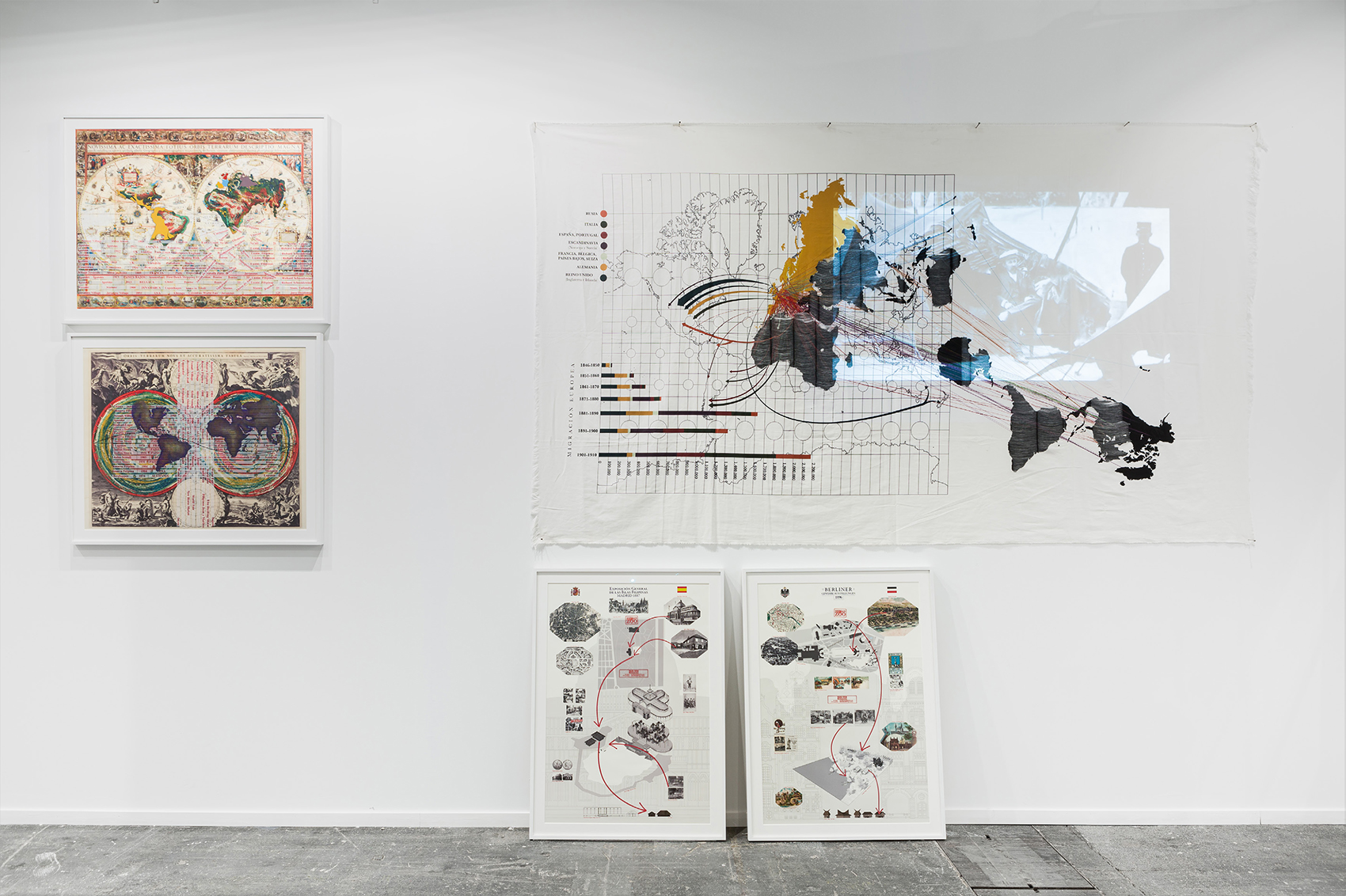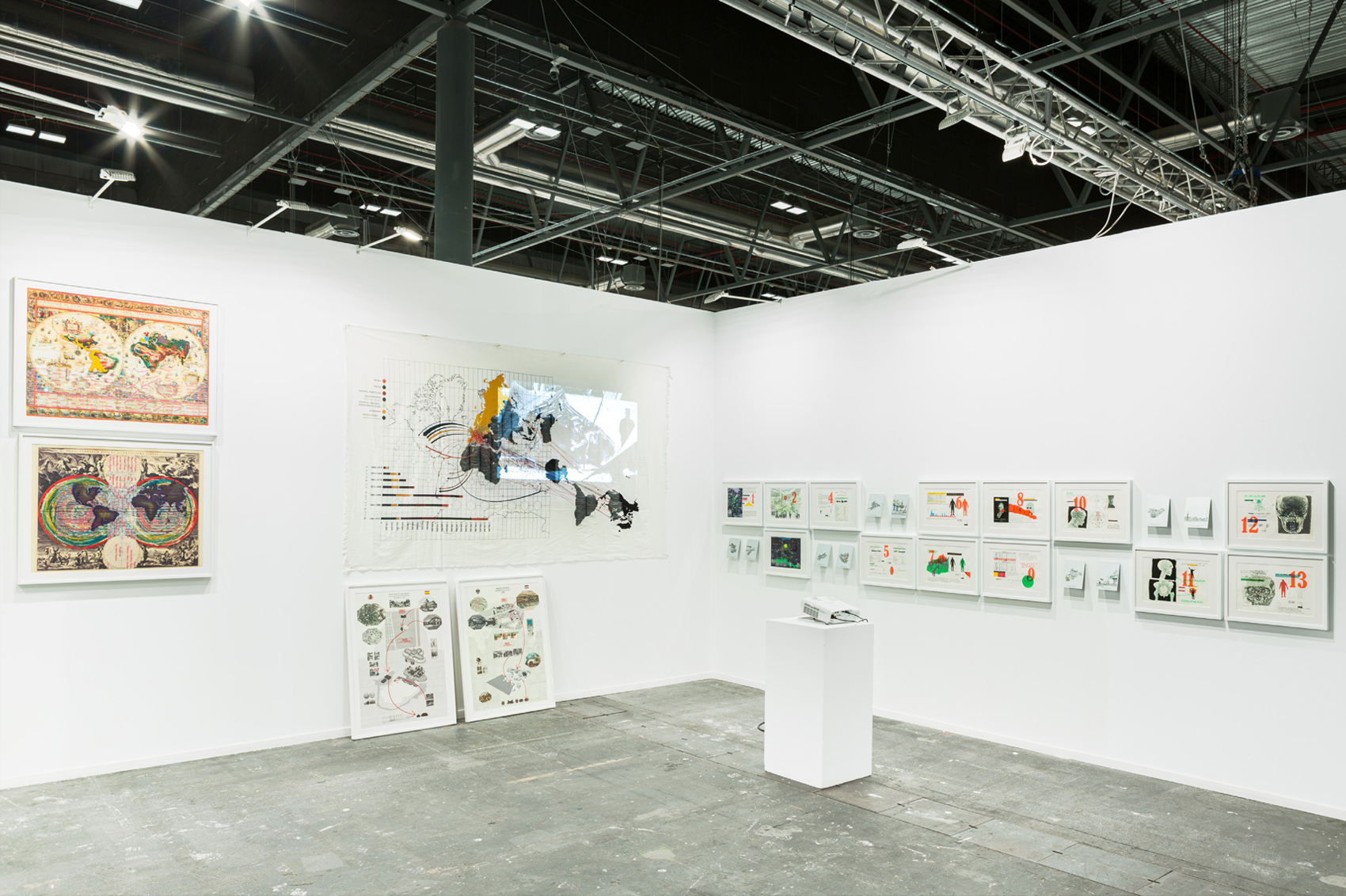
Zoo + Syndemic Studies
Zoo is a series of works that interweave maps of the European colonial processes of the 17th century, posters that analyze the historical and urban phenomenon of the human zoos in Madrid and Berlin (the complete series is
of eight cities) and the configuration of a new map that puts in relation two geopolitical and social variables that occur simultaneously: the migration from Europe to America and the exhibition of ancestral peoples from different points of the globe, in human zoos housed inside Universal or Colonial fairs.
1. Colonial maps belong to the Serie Cartografía de la colonización, of which 1634 (Dutch world map) and 1670 (Dutch world map) are exhibited, printed and intervened with paint according to the process of expansion in America at that time. Lists of names of peoples exhibited in zoos 250 years later are superimposed on them. These lists were extracted from the research we carried out on the phenomenon of zoos, in which we counted 1300 human zoos documented between 1848 and 1958. Each map contains the shock of evidencing the processes of colonization, suprematism, and racism that resulted in human zoos.
2. Posters of three cities with Human Zoos belong to the Serie Zoológicos humanos-emplazamientos
1886- Madrid: Crystal Palace
1896- Berlin: Trade Exhibition
Each poster is the visual synthesis of the archival research we investigated by asking ourselves how the human zoo exhibition had impacted the city where it was exhibited, what scenographic resources constituted the show, and how the idea of civilization and barbarism, progress and savagery, were the urban signs that the human zoo show served to popularize in the different European cities and capitals where it was produced. We understood the construction of these signs as necessary for the process of colonial expansion supported by the construction of the homogenization of the white European race at the same time that racism was popularized.
3. Zoo-migration-audiences Map
The last map, printed on fabric, is constructed from the interweaving of four historical variables that imply rethinking the colonial processes:
1. Mercator Map (in gray line) rectified by the 2016 Authagraph map (in black and yellow) by designer and architect Hajime Narukawa. In this new map,
the deformation of the representation of the roundness of the earth and the disproportionate enlargement of the Northern Hemisphere of the Mercator map are corrected. Additionally, colored lines indicate the origins of approximately 40,000 individuals who were exhibited in human zoos and the locations where they were exhibited in Europe, between 1848 and1958.
2. Simultaneously, the same map shows the immense process of migration of European people to America between 1850 and 1910. Crossing different archival sources, we understand that 70 million Europeans migrated to the Americas
in just 60 years, mostly due to the social reconversion process implied by the Industrial Revolution, thus, most of the poor classes sought this solution to their lives, parallel to the fact that the ancestral peoples whose culture did not coincide with the universal ideas of civilization and progress were exhibited. It should be noted that this migration data was obtained through American and Latin American archives, since the information is scarcely analyzed in Europe. One question that arises from this variable is whether these migrants would have known about or attended human zoos.
3. The third element of this piece is a video projection composed of film clips of the audiences that visited the human zoos. Through fragments, we can see these people having fun at the Universal and Colonial fairs that often housed human zoos inside. The video concentrates only on the spectator who looks at the exhibited person, and the exhibited person cannot be seen, since we have digitally erased him, reflecting on who is the one who looks and what
he looks at, since it is known in anthropological terms, that human zoos were very efficient in popularizing racism in those 400 million people who were their spectators during the 110 years in which they existed.
exhibición:
INTERNATIONAL CONTEMPORARY ART FAIR
ciudad:
país:
Especificación:
2021
ZOO
- Serie Cartografía de la colonización - 1634 (Colonization Cartography Series - 1634)
Digital print, ink and collage on polyester paper
- Serie Cartografía de la colonización - 1670 (Colonization Cartography Series - 1670)
Digital print, ink, colored pencils, and collage on polyester paper
- Cartografía Incógnita (Unknown Cartography)
Digital print on fabric and video projection
- Serie Zoológicos humanos - emplazamientos: Madrid (Human Zoos Series – Locations: Madrid)
Fine art print on paper
- Serie Zoológicos humanos - emplazamientos: Berlin (Human Zoos Series – Locations: Berlin)
Fine art print on paper
2021
SYNDEMIC STUDIES
- Estudios
13 dibujos técnica mixta y 10 impresiones en placas de aluminio

